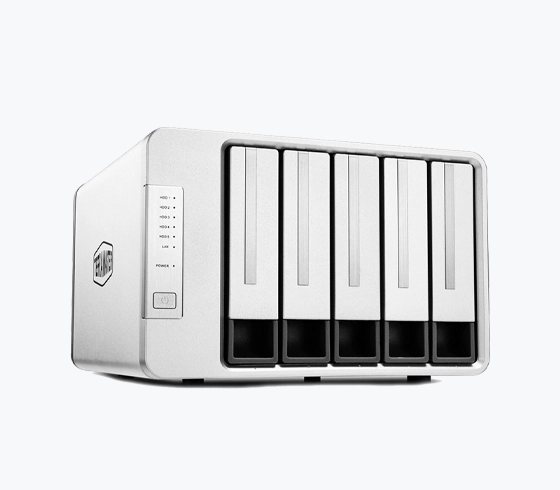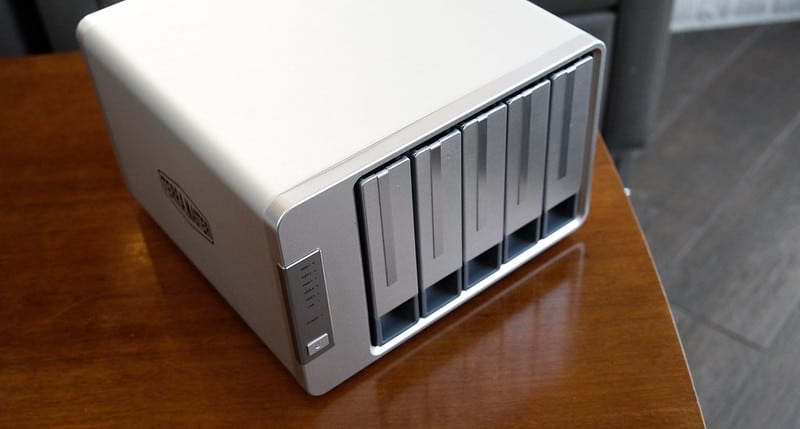NAS devices like the TerraMaster F4-210 are widely used by small businesses and advanced home users for centralized file storage and media sharing.
While cost-effective and capable, their reliability hinges on both healthy hardware and proper RAID configuration.
In this case, a client experienced a critical data loss event after their TerraMaster F4-210 NAS suddenly failed, leaving a RAID 5 array inaccessible and years of valuable project data at risk.

Case Background: What Happened?
The client used a TerraMaster F4-210, a 4-bay NAS powered by a quad-core ARM processor, configured with four 4TB drives in a RAID 5 setup.
This configuration offered redundancy for a single drive failure and was used to store:
Business documents
Multimedia project files
Client archives
Family photos and videos
One morning, the NAS became unresponsive during boot. After a manual restart, the system interface failed to load, and none of the shared folders were accessible from the network.
The client attempted basic troubleshooting, including:
Restarting the NAS
Checking drive status via TerraMaster TOS
Swapping network cables and ports
Despite these efforts, the NAS did not mount the volume, and the TerraMaster admin panel reported “RAID degraded” followed by “Volume not found.”
At this point, they contacted RAID Recovery Services for professional assistance.
For more details on how we handle these types of failures, see our TerraMaster data recovery capabilities.
Initial Evaluation: Drive Status and RAID Integrity
Once we received all four drives and system logs (exported by the client), our engineers began with a full hardware evaluation. Key findings included:
One drive had completely failed (multiple unreadable sectors and mechanical wear)
Another drive showed early signs of failure (reallocated sector count increasing)
The remaining two drives were healthy
No recent backup existed outside the RAID array
The TerraMaster OS had attempted to auto-rebuild the RAID array when one drive failed, but the degraded second drive caused the rebuild to fail, corrupting the array’s parity and metadata.

Challenges in Recovering TerraMaster RAID 5 Arrays
TerraMaster NAS systems use mdadm-based software RAID under a Linux environment, often layered with ext4 or Btrfs file systems.
However, when rebuilds fail or drives fall out of sync, RAID 5 arrays can suffer:
Fragmented stripe alignment
Missing or misaligned parity blocks
File system corruption
These issues are common across many RAID 5 configurations, making RAID 5 data recovery one of the more technically demanding services we perform.
Since the TerraMaster F4-210 runs on an ARM-based CPU, standard x86 Linux recovery tools must be carefully adapted to read and emulate the original RAID configuration.
Fast turnaround times for business-critical data
Recovery Process: Step by Step
All four drives were cloned sector-by-sector using write-blocking hardware to preserve original data and prevent further degradation.
Using disk images, we identified the correct RAID order, stripe size, and layout. Our team virtually rebuilt the RAID 5 array using custom tools to correct parity inconsistencies caused by the failed rebuild attempt.
The underlying ext4 file system was severely damaged. Our engineers repaired corrupted superblocks and inode tables to restore directory access and recover original folder structure.
Recovered files included:
Photoshop and Illustrator files
Large 4K video archives
Business tax records
Personal photo and music libraries
Over 97% of the original data was fully restored.

Quality Control and Final Delivery
Once the extraction was complete, we:
Validated file integrity using hash checks
Manually opened key files to confirm usability
Generated a full recovery report for the client
A remote verification session was scheduled, where the client reviewed folder structure and confirmed critical files were present. The recovered data was transferred to a new 8TB external drive and shipped with tracking and encryption.
Summary of the Recovery
Device: TerraMaster F4-210
RAID Type: RAID 5 (4 x 4TB drives)
Issue: One failed drive, one degraded, failed rebuild corrupted volume
Data Recovery Success: 97.3%
Turnaround Time: 4 business days (priority service)

Best Practices for TerraMaster Users
To reduce the risk of future failures:
Use dual-disk redundancy (RAID 6 or RAID 10) if possible
Avoid automatic rebuilds without drive health verification
Backup critical data to cloud or external USB periodically
Replace drives at the first SMART warning (especially with increasing bad sectors)
Use UPS systems to prevent sudden shutdowns that can corrupt parity and file system data
Improper or premature rebuild attempts can result in complete data loss.
Trust the experts with proven results
Need Help with Your TerraMaster RAID Recovery?
If your TerraMaster NAS has failed or become inaccessible due to drive issues or a software-level crash, don’t attempt a DIY rebuild.
Contact RAID Recovery Services for a risk-free evaluation. We have extensive experience with TerraMaster RAID arrays, Linux mdadm environments, and file system repair.
Our labs are equipped to recover data from even the most complex NAS failures. We also offer comprehensive NAS data recovery services for all major brands and failure scenarios.